June 8th 2019 in Maassluis: The Day of the Deep Sea Towage celebrates 250 jubilee years!
"The Day of the Deep Sea Towage" in Maassluis this year 2019 took place on Saturday June 8th and memorized in total 250 years of jubilees. The Seagoing Tug Hudson exists 80 years, the ex pilot ship Rigel of the Maassluis Sea Scouts 70 years, the Deep Sea tug Elbe 60 years and - last but not least - the National Dutch Towage Museum 40 years.
In the outer harbour the historical ships of the "Tugboat Harbour Maassluis Foundation" could be admired closely on this day. But also our good neighbour, the former pilot ship Rigel, and a number of guest ships from other locations were present. Some of these ships organized tours in the Harbour and on the river for visitors.
Information about these tours and programmes could be obtained from the website www.sleepboothaven.nl and on social media. Tickets were sold from april till this day.
 However, because of the stormy weather the nautical market and the shanty choir performances on the quays were cancelled.
However, because of the stormy weather the nautical market and the shanty choir performances on the quays were cancelled.
From ca. 17.00 h the traditional line-up of ships was formed on the river Nieuwe Waterweg. All kinds of tugs could be seen, old ones, modern ones, small ones and very big ones. Because of the weather a number of smaller tugs, and the Bruinvis and Furie dit not leave the harbour. One could take part and buy a ticket on the famous tugboat Holland. The tugboat departed at 16.00 h sharp. It was a beautiful sight to see those ships passing the harbour heads of Maassluis.
If you are interested in this day, please read the websites www.sleepboothaven.nl, Facebook (www.facebook.com/sleepboothaven) en Twitter (www.twitter.com/sleepboothaven).
A story by Job van Eijk
“Maassluis – Tugboat Port” is the title of the latest exhibition by the Dutch National Towage Museum. It will run until 19 October, 2014. But how did Maassluis come to earn that title?
On 16 May, 1614, an ‘Act of Separation’ was signed. This year, the city of Maassluis, The Netherlands, thus will have been on the map for exactly 400 years. The story, however, begins much earlier, in the 1100s. At the time, the entrance to - then - River Merwede was a very wide one, including much of what is now known as the Westland area as well as Europort. In fact, the city of Vlaardingen was the then most western village on the banks of the River Merwede.
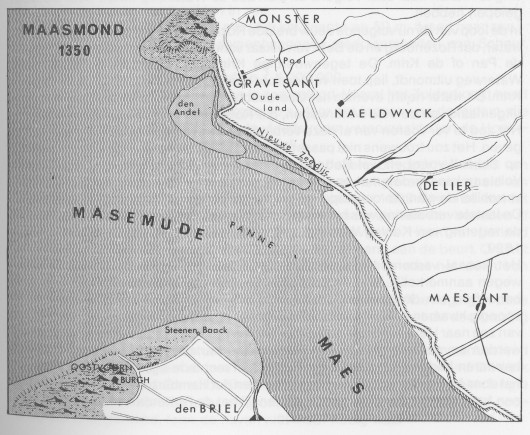
As the land was lying low and partly tidal, an extensive array of dikes and dams was built to keep what was in fact the North Sea in check. Between 1134 and 1164 a number of large floods devastated part of these works. A dedicated effort was made to remedy this situation and around 1260 a large dike was finally completed closing off the lower lying grounds from high tides. To get rid of excess water waterways were dug which spilled in the river by means of controllable gates. These waterways were dug to the order of the individual villages. No less than 13 such ‘locks’ were constructed in what was then known as the Maas Dike. The Noordvliet and Zuidvliet were dug by the neighbouring villages of Monster and Wateringen and – as they were within spitting distance of each other, the gate keepers became the first permanent inhabitants of what was then known as Maeslantsluys (‘sluys’ translates as ‘locks’).
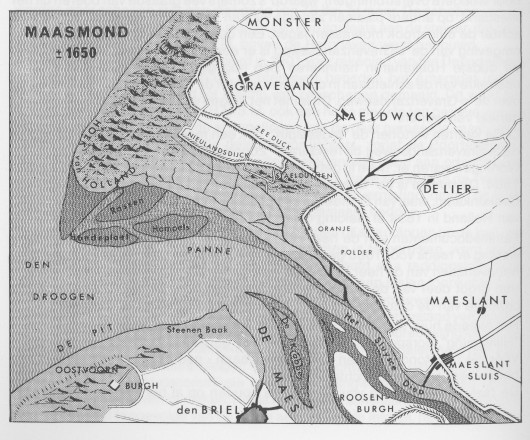
Outside the locks a fishing port developed which brought prosperity due to its supporting industries like shipbuilding, shiprepair, rope-making, etc. Since Maeslantsluys was a part of the village of Maasland – a farmer’s community - all taxes went into the coffers of the latter with little coming back. A campaign was started to become independent which succeeded in 1614.
It would take another 250 years for the first tugs to arrive in the port. The reason for this was the fairway from Rotterdam to sea. Around 1740 the shortest way was via the Brielse Maas. The distance to Rotterdam was some 35 kilometers but this fairway was unreliable with constantly shifting bottom and a lot of silting up – sometimes only 2,5 meter of water was available. Larger ships were forced to take the 95-kilometer route via the Goereesche Gat, Haringvliet, Hollands Diep, Dordtse Kil and Oude Maas.
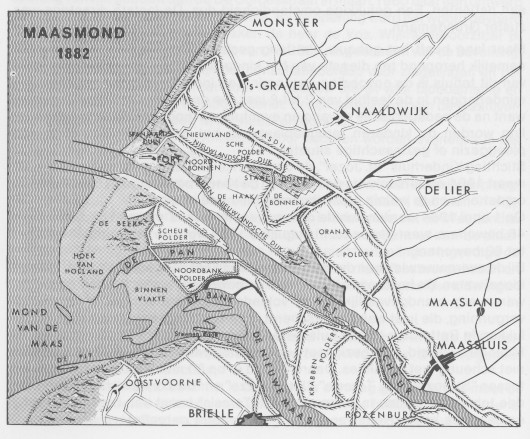
In 1830 King Willem I had the Voornse Canal built which shortened the long route to 40 kilometer. Soon, however, this channel became too narrow. The ships became bigger all the time and the early steamers even had to be routed over 135 kilometer via the Easter Scheldt In order to become more competitive a short and reliable route to the North Sea had to be found. As early as 1739 alternative routes had been thought of but impractical at the time due to construction problems. Finally, a plan by the engineer Pieter Caland was accepted and on 23 March, 1864, the first sand was moved. The plan was to dig a fairway from the Scheur (near Maassluis) through the dunes at the Hook of Holland. This shortened the route to Rotterdam to just 30 kilometers. In September, 1869, the first fishing vessels used the direct route to sea. On 9 March, 1871, the first seagoing steamer – Richard Young, a Cross-Channel steamer – sailed the New Rotterdam Waterway.
The tugboat era
At that time, the Pilotage Service was transferred to the port of Maassluis which was closest to the sea (the port of Hoek van Holland while closer was a small government-owned port intended for work vessels only). Another service-provider to establish itself at Maassluis was the Alblasserdam-based tugboat operator L. Smit & Co. Established in 1842 as the Sleepdienst Fop Smit, their tugs were first stationed in Maassluis in 1869, anticipating demand and strategically locating their tugs midway between Rotterdam and the sea. The first tug to be stationed at Maassluis was their paddle tug Zierikzee. This was the start of Maassluis as a tugboat port.
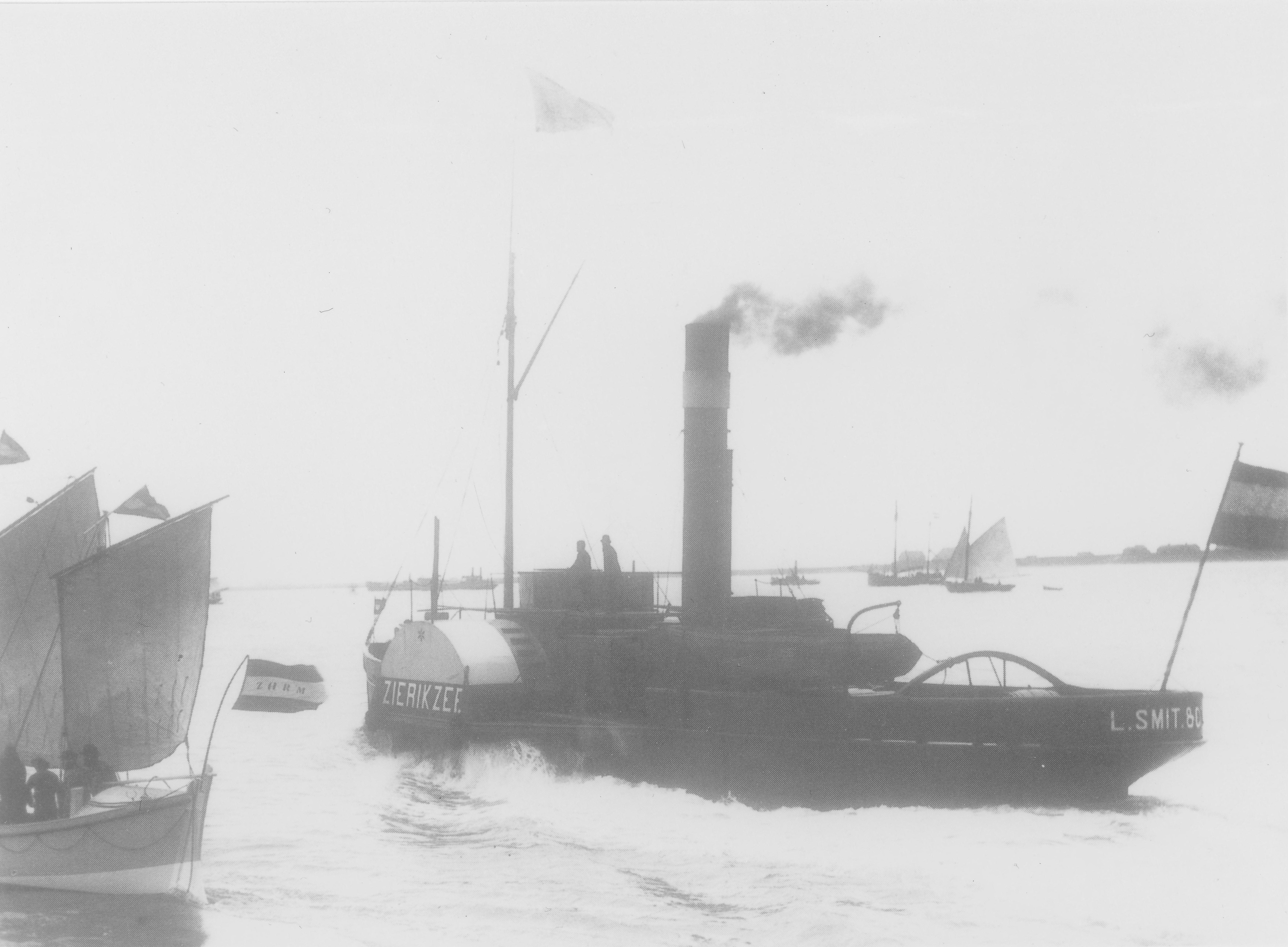 Zierikzee - the first Smit tug operating from Maassluis Zierikzee - the first Smit tug operating from Maassluis |
It had been expected that the Rotterdam Waterway itself would maintain depth in the fairway. This was a miscalculation and dredging was a necessity. It was the invention of the suction hopper dredger that made large-scale dredging possible. In the meantime ships frequently ran aground. The big liner companies therefore stimulated the construction of powerful tugs to assist their ships. It was for this reason that more powerful seagoing tugs were stationed at Maassluis which from then on remained the base for Smit’s sea- and oceangoing tugs. In 1880 Smit had opened a small maintenance and repair shop at Maassluis which in 1892 was extended with an office building.
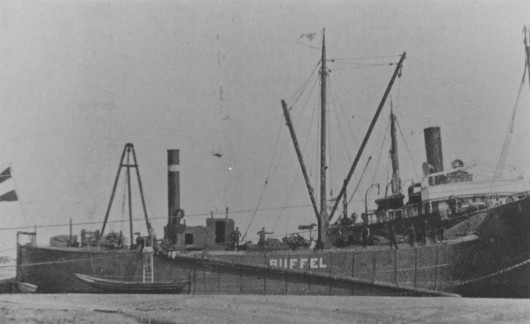 The Bergings Maatschappij operated dedicated salvage vessels like BUFFEL - photo coll. Job van Eijk
The Bergings Maatschappij operated dedicated salvage vessels like BUFFEL - photo coll. Job van Eijk
The frequent groundings attracted other players and in 1887 the Berging Maatschappij (Salvage Company) was established by Dirkzwager, a Maassluis-based shipping agent. The company had a number of dedicated salvage vessels built. Tugs, however, were hired from local operators. The company was established with support from the big liner companies for exactly the same reason they supported Smit’s tugs. So when the Waterway was deepened sufficiently, there was insufficient need for the salvage fleet. At that point, the company extended its operations beyond the Waterway area..
The Rotterdam Waterway was not the sole domain of L. Smit & Co. In 1897 the Sleepdienst Hoek van Holland was established. In 1899 this company also established a small repair workshop at Maassluis.
Earlier, in 1893, Sleepdienst Vuyk was established with support of the Rotterdam-based American Petroleum Co. In 1900 the company was absorbed in the newly established Internationale Sleepdienst Maatschappij (International Towage Co.) which was effectively Vuyk with another shareholder and a wider ambition. The ISM came in direct competition with L. Smit and set up operations at Maassluiis and various other ports in the Rotterdam – Hoek van Holland area. The ISM was very active and well-connected. In 1901 it purchased the earlier mentioned Sleepdienst Hoek van Holland. With this transaction it also gained the workshop in Maassluis. ISM also entered into a full-blown competition at Amsterdam, but here it failed. A more successful venture were the excursion boats to Hoek van Holland and Scheveningen.
In 1907 a Swedish salvage steamer was stationed at Maassluis. Operated by the Swedish Neptun company the venture was short-lived and Belos quickly disappeared to more lucrative areas.
- Smit & Co. was also active in salvage. From 1898 to 1902 they had an agreement with the Bergings Maatschappij for joint operations on the Waterway and the Dutch coast. This contract was ended in 1902 when Smit started a co-operation with van den Tak which later would become a household name in the salvage industry: Taks Berging, Takmarine, Smit-Tak. The Tak name would remain in Maassluis until 2004 when the salvage stores where transferred to Rotterdam.
In 1923 the decision was taken to merge the operations of L. Smit & Co. and the Interantionale Sleepdienst Maatschappij into L. Smit & Co’s Internationale Sleepdienst (L. Smit & Co’s International Towage Co.). The constituent companies remained independent for a great many years but to all intents and purposes it had become a single company. Although the headquarters would be in Rotterdam, the deepsea and salvage fleet was to remain based at Maassluis. At the same time Dirkzwagers Bergings Maatschappij was dissolved, with the fleet and equipment taken over by the new company. From that time on, the ocean tugs would carry a blue band around their funnel and being named after rivers, seas and oceans while the harbour fleet would sport a red band.
The company had the largest fleet of dedicated oceangoing tugs in the world. At the time of the ‘merger’ the combined fleet totalled 59 tugs, amongst which 16 oceangoing tugs. At the start of WW II the oceangoing fleet consisted of 21 tugs. In 1946 10 were left. By 1960 the fleet numbered 20 oceangoing tugs. In 1963 the fleet totalled 28 but from then on the numbers went down in addition to a number of vessels being stationed in the Far East.
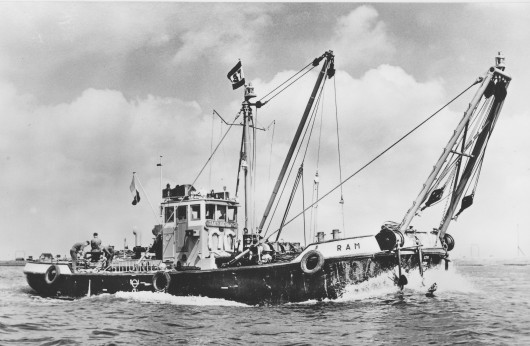
The 1963-built Zwarte Zee (9.000 hp) was the first in the Smit fleet which was too large for the port of Maassluis. As larger units entered the fleet and older units disposed of, the activities in the tugboat port gradually slowed down – as far as tugs is concerned. The last Smit oceangoing tugs to leave the port were Thames in 1979 and Schelde in 1980.
Historic awareness
In the mid-1970s a number of initiatives were taken which were to lead to a renewed interest – by a wider audience – in the towage business. In 1974, the Lekko Society was established with its seat formally at Maassluis. It’s aim was to unite worldwide people with an interest in tugs and towage. A magazine was started, tug visits were made, meetings were held. In 1978 a private initiative was taken to convert the old city hall – dating from 1676 – into a towage museum. The municipality of Maassluis supported this initiative, as well as a number of the Dutch towage companies and the Lekko Society. The Dutch National Towage Museum is situated on the inner harbour of Maassluis and regularly presents themed exhibitions, in addition to the permanent expo.
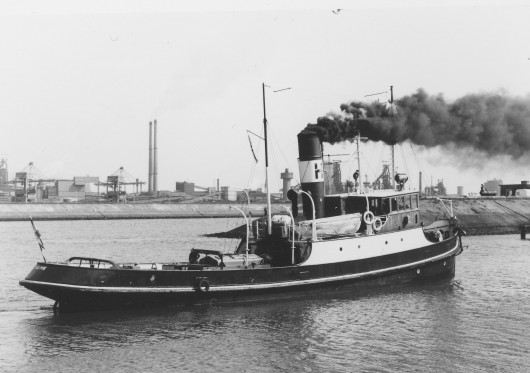
HOLMVIK arriving at IJmuiden from Sweden to become the star of the Dutch television series Hollands Glorie (Dutch Glory) based on the famous book by Jan de Hartog - photo coll Job van Eijk
Around the same time a television series ‘Hollands Glorie’ (Dutch Glory, based on the famous book by Jan de Hartog) was screened. The tug which was used in this series was actually a Dutch-built seagoing tug dating from 1916, located in Sweden with the help of the Lekko Society. Destined to be scrapped after the series was shot the tug was rescued from this fate and restored to its former glory. The fully operational tug was brought to Maassluis and is now moored behind the Towage Museum. She is also the core of the annual Furiade Festival, which also attracts a lot of tugs to the port. Not only small ones, but big – preserved - ocean tugs now also form part of the festivities.
The port of Maassluis remained active and even some of Smit’s shiphandling tugs were stationed at the port though they have since disappeared again. Other (non-tug) operators have taken their place. Tugs, however, kept visiting the port. This was due to the Shipyard De Haas which over the years has earned the title of ‘hospital of the port of Rotterdam’ because an endless streamof port support vessels is being maintained and repaired at the last remaining Maassluis’ shipyard. The yard dates from 1879 when Hendrik de Haas started the yard ‘Zorg & Vlijt’.
The yard, which is still owned by the De Haas family also built quite a lot of tugs. In 1948 the tug Maassluis was completed for account of L. Smit & Co’s Internationale Sleepdienst. This little harbour tug was the only one in the fleet to carry the blue-on-black funnel of the oceangoing tugs. She was stationed at Maassluis to assist the big tugs. Today, this tug is back again in Maassluis and fully restored to her 1948 looks. Owner is mr Luuk Vroombout, director of Alphatron, a marine electronics firm. Mr Vroombout also initiated the Maassluis – Tugboat Port plan which aimed to revive the outer port as a working museum.
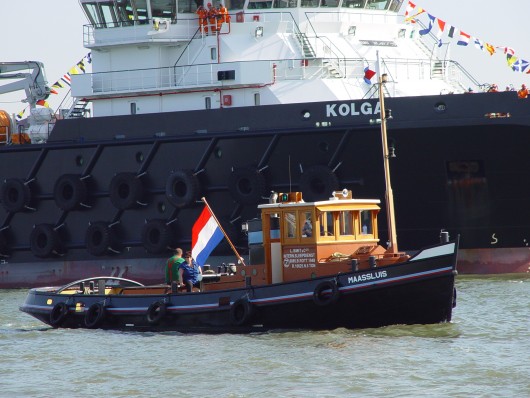 The tug MAASSLUIS fully restored. Dwarfed by one of the biggest tugs in the world, Heerema's KOLGA, she is now owned privately and part of Maassluis Tugboat Port
The tug MAASSLUIS fully restored. Dwarfed by one of the biggest tugs in the world, Heerema's KOLGA, she is now owned privately and part of Maassluis Tugboat Port
In 2005, several tugboat preservation attempts were running. Preservation of the tug Hudson - the pre-war prototype of a new design for Smit’s oceangoing tugs – had already been accomplished with the tugs new function being a floating – and transportable – museum on the Dutch merchant navy in World War II. The far bigger post-war Elbe – at the time of delivery one of the most powerful tugs in the world – was in the process of being restored to a fully operational vessel. This tug was to be moored in the outer harbour. At about the same time the Taksberging salvage vessel Bruinvisch – representing the series of pre- and post-war salvage vessels based on the ‘blazer’ type of fishing vessel – was returned to Maassluis for preservation. It seemed a good idea to facilitate these efforts and combine this into a working historical port operation. Not only to exhibit but also to maintain old-fashioned workmanship and shipbuilding- and repair skills.
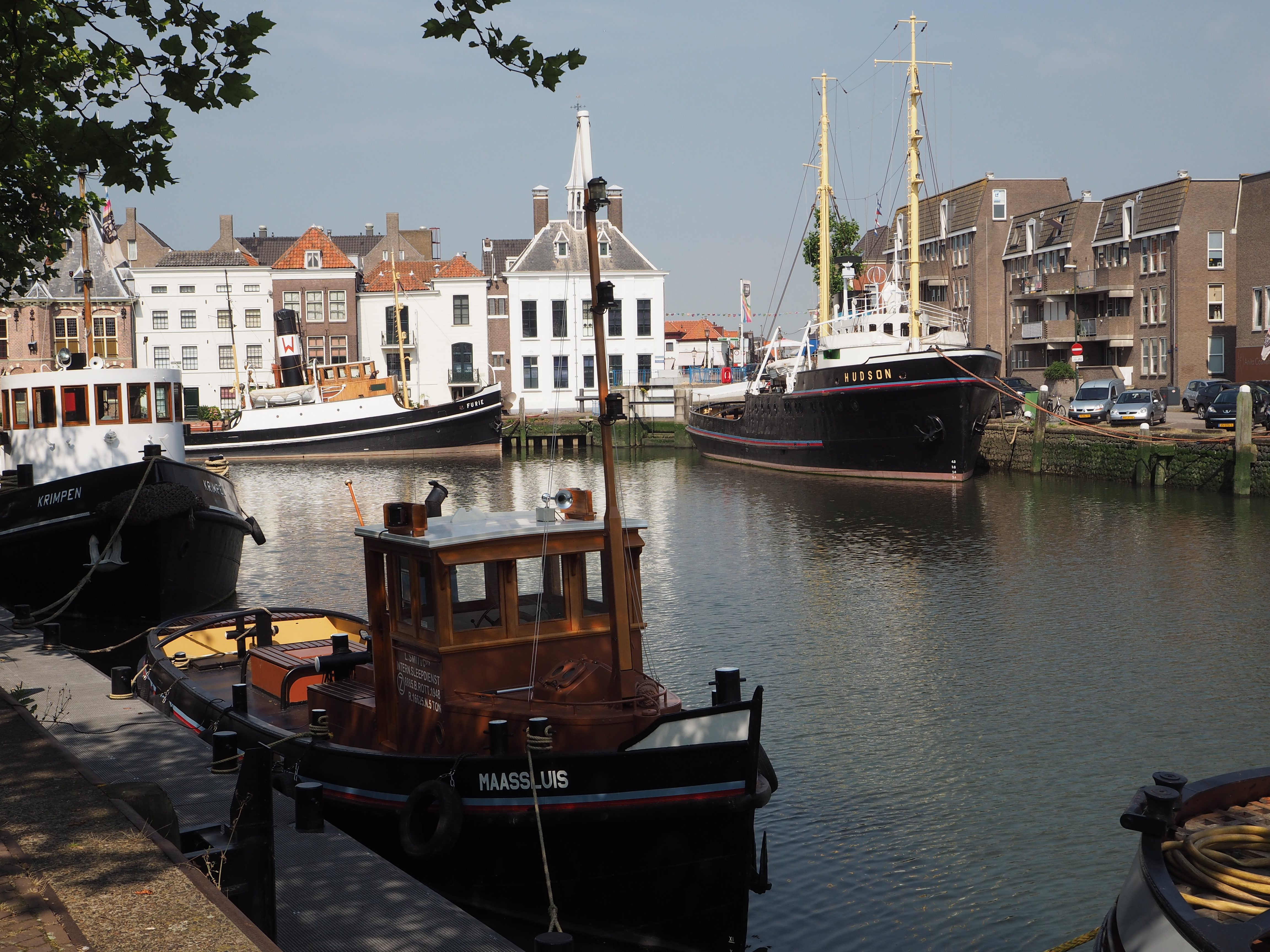
Another tug – privately owned – is the Krimpen, an immediate post-war shiphandling tug. A large series of this type was built for account of Smit; partly by shipyard De Haas. She is usually moored in the inner harbour. Another tug frequently in port is the Adriaan, a fully operational tug formally owned by Kooren but no longer on the active list.
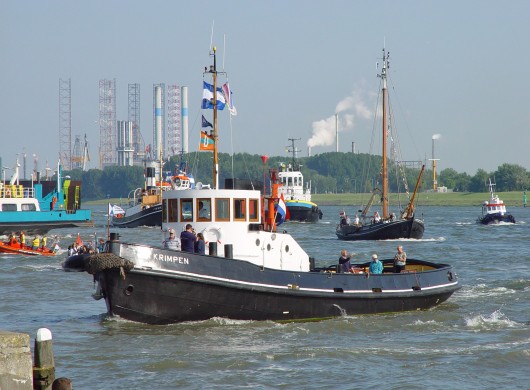 KRIMPEN in 2014 - photo Job van EIjk (TugDoc International)
KRIMPEN in 2014 - photo Job van EIjk (TugDoc International)
Apart from the preserved tugs there are two towage operators still active. Sleepbedrijf H.J. Wesselius started in 1951 as a fuel dock located in the inner port of Maassluis. Soon, a tugboat service was also provided. A tug currently operated by Wesselius is Mehari. This tug was built in 1969 by Shipyard De Haas as one of a series of four near identical vessels. Built for the dredging form of Oosterwaal the tug returned to Maassluis in 1979 when she was acquired bij Rederij Waterweg. This company had been established in 1970 by Henk de Haas. The tug Jil was built for his own account by the family-owned shipyard. To run this independently from the yard Rederij Waterweg was founded. In December 1985 Henk de Haas left the yard to concentrate solely on towing. The company shifted to Workum in 1986. The tugs, however, had meanwhile been stationed in Den Helder which at the time had no significant tugs apart from the naval tugs, which did not operate in the commercial port. Rederij Waterweg today is known as Acta Marine and still going strong, although no longer owned by De Haas.
Incidentally, Henk de Haas was also instrumental in saving the Furie, mentioned earlier. For this purpose the Hollands Glorie Foundation was established in 1977.
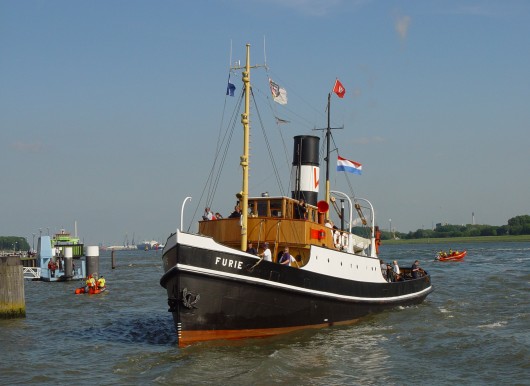 FURIE, ex HOLMVIK, at the Day of OCean Towage 2014 at Maassluis - photo Job van Eijk (TugDoc International)
FURIE, ex HOLMVIK, at the Day of OCean Towage 2014 at Maassluis - photo Job van Eijk (TugDoc International)
The latest tug operator to be established at Maassluis is a subsidiary of Gareloch Support Services, based in Scotland. It started in 2011 with the acquisition of a Eurocarrier followed in 2011 by the Damen Shoalbuster 3209 type tug Liz F, 3.500 bhp and a bollard pull of nearly 50 tonnes. Registry: Maassluis. The most powerful tug operating from Maassluis ever and at the same time the only seagoing tug ever homeported at Maassluis – the Smit tugs always had Rotterdam on the stern.
This brings the story to where it started – the exhibition in the National Towage Museum. The exhibition was officially opened by Mr Govert de Haas, current director of shipyard De Haas. He did so by ringing the ship’s bell at the entrance to the museum.
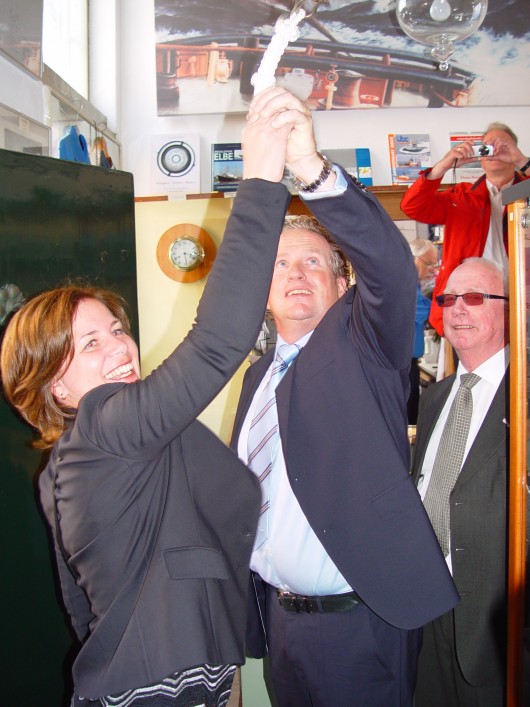
This is the original bell of the first tug named Zwarte Zee, completed in 1898. The tug was sold to Russia in 1905 which was the start of a long journey in the Pacific area until the tug ended up with owners in Hong Kong. Active until 1947 the bell disappeared until it was spotted by a Dutch seaman somewhere in the mid-1980’s. And now forms part of the collection of the museum.
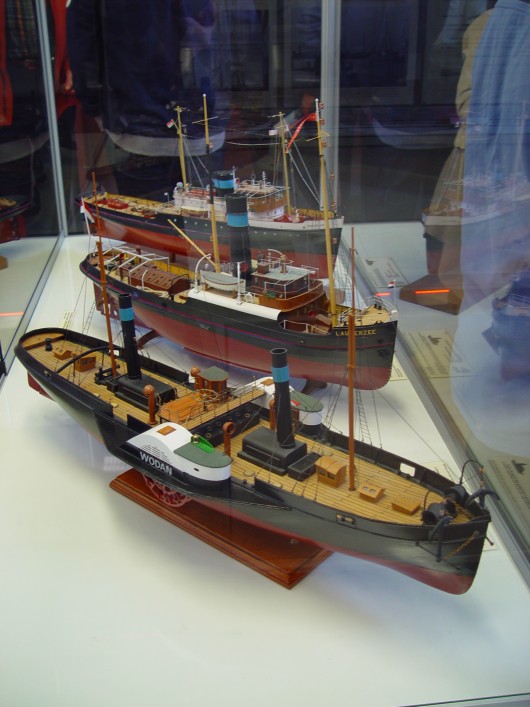
After the successful official opening the impressive exhibition could be visited. The photographs rang a lot of memory bells with the invited, amongst which management of a number of Dutch tug operators.
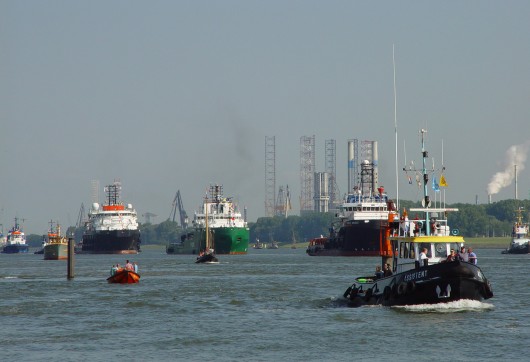
To round off the week two days later, at the time of the ‘Day of Ocean Towage’, the 400-year Maassluis festivities were started with a sail-past of numerous vessels which had or have a connection with Maassluis: inland waters vessels, fishing vessels, coasters various types of sailing ships, pilot boats and a lot of tugs. Fortunately, on that day a number of foreign tugs were also in port and the owners agreed to participate in the event showing the crowds some of the biggest tugs in the world.
Sources: - Rotterdam 650 jaar – various authors; De Nieuwe Waterweg – Gerrit vd Burg; Maassluis-Sleepboothaven – exhibition guide, Bergers van het eerste uur (Dirkzwager) – J.P.A. Verkley; Smit 150 – G.J. de Boer; Along coastlines and shallow waters (Rederij Waterweg 1970-2006) – Paul Schaap.
Note: this article is copyright TugDoc International / Job van Eijk and was earlier published in Lekk International 208, August 2014.
New book: "Towage in Rapids"

‘Towage in Rapids’ or ‘Sleepvaart in Stroomversnelling’ in Dutch, is the newest book by volunteer and former board member of the National Towage Museum, Nico Ouwehand. This new volume reviews and updates the histories of 40 years exchange exhibitions and contains many exclusive photographs from the Museum’s large own collection and many other contributors. The book can therefore be seen as an anthology of all aspects of ‘Dutch Glory’, as the industry is proudly called by Dutch enthusiasts, and of the many companies that made the Dutch Towage industry world famous over some 175 years.
The book can be purchased locally from June 8th, during the ‘Day of Ocean Towage’ in Maassluis. The book can be obtained in the National Dutch Towage Museum, and also be ordered through the Website of the Museum: www.nationaalsleepvaartmuseum.nl.
Please take in consideration that additional shipment cost is due, in case of delivery outside the museum.
Author: N.J. Ouwehand
Published: 2019
Publisher: Lanasta
Language: Dutch
Full colour
To be delivered from: June 8th 2019
Non-fiction
ISBN: 978-90-8616-268-0
EAN: 9789086162680
344 pages
Many photographs and illustrations
Weight: ca. 2 kg
Price: € 25,00 (postage and delivery cost not included)
Please take in consideration shipment cost, in case of delivery outside the museum
 Left: 1979: opening 1st exhibition
Left: 1979: opening 1st exhibition
This year the National Dutch Towage Museum in Maassluis, the Netherlands, still the only dedicated towage museum in the world, exists 40 years.
To celebrate this milestone, the National Dutch Towage Museum has organized a special exhibition on the interesting history of the Museum, titled ‘Towage in Rapids’. In addition the Museum has published a beautifully executed anniversary book, with the same title.
The exhibition displays who from the Municipality of Maassluis and the Dutch towage firms have contributed in the early stages to the founding the museum. Also changes among the many volunteers, the expansion of the Museum building and highlights of the numerous exchange exhibitions are extensively presented. Examples of the most celebrated exploits by famous steam tugs up to highly versatile and powerful modern vessels of today can be seen on photo, film or as large scale model.
The exhibition halls have been renovated recently in an attractive modern style and equipped with new simulators, video screens and digital tug information systems.
On the photograph displays many familiar faces can be recognized, like as Ir. G. Langelaar Gzn. who, nearing his pension, became one of the driving forces behind the establishment of the Museum and who was the first to be appointed chairman.

‘Towage in Rapids’ or ‘Sleepvaart in Stroomversnelling’ in Dutch, is the newest book by volunteer and former board member Nico Ouwehand of which the first copy will be handed to Robert-Jan van Acker, Group Director Towage and Salvage of Boskalis during the opening of the new exhibition. This new volume reviews and updates the histories of 40 years exchange exhibitions and contains many exclusive photographs from the Museum’s large own collection and many other contributors. The book can therefore be seen as an anthology of all aspects of ‘Dutch Glory’, as the industry is proudly called by Dutch enthusiasts, and of the many companies that made the Dutch Towage industry world famous over some 175 years.
The book can be purchased locally from June 8th, the ‘Day of Ocean Towage’ in Maassluis in the Museum or can be ordered through the Website of the Museum: www.nationaalsleepvaartmuseum.nl.
The exchange exhibition ’40 years Towage Museum’ can be seen from June 8th until October 19th 2019.
For further information please contact This email address is being protected from spambots. You need JavaScript enabled to view it. or +31 (0)10 – 5912474.
For more information about the exhibition, please click and open "exhibition manual" beneath (in Dutch).
Tugboat USA
Newsletter National Dutch Towing Museum, June 2018
In this newsletter you find information about the following subjects:
The preface of this newsletter has been written for the first time by the new chairman of the National Dutch Towage Museum, mr. Kees van Essen, who is the successor of mr. Karel Kaffa. In this document he introduces himself in more detail.
At the same time, we welcome our new financial manager, mr. Martin Boekestijn. He also shows an insight in his credentials.
Apart from these two gentlemen, the Museum is happy to announce that another two persons volunteered for our institute, Paul Firet and Aart van Eijsden.
In this edition of the newsletter we memorize mr. Teunis van der Maarel, who regrettably abruptly deceased this month. He was considered as the operational manager of the Museum, who did an excellent oversight and coordination job. He also acted as an undaunted and thrustworthy compass for the Museum and its volunteers, and on which one could always rely and who nearly always was present in the Museum.
We are pleased to announce that after the completion of the Zeezaal (Deep Sea towage Hall) we now also have at our disposal a totally reconstructed Rijn- en Binnenvaartzaal (River and Inland towage Hall) and Havenzaal (Harbour Towage Hall).
The museum received new equipment of good quality for digitalizing old pictures and videos for our two cinema systems.
In this period the Museum again added a number of new ship models to its collection.
Furthermore the experts of the Museum on request of relatives now alive, a number of times were able to recover the vicissitudes of crew members of tug boats in the past. Read the fascinating story about the escape of mr. Middendorp, that we recovered on request of his daughter by intensively consulting and exploring our archives and other sources.
On June 2nd the new exhibition "Van bouwsteen tot sleepbootmodel" (from building block to tug model) went live. It is unimaginable how much keenness it takes to build true and detailed tug models using LEGO and other building block systems. The in connection with this exhibition organized building contest was very successful. Especially children and young adults were very interested.
And last but not least, for those who are interested we mention that the annual report 2017 can be downloaded via the link in the newsletter. You find a very detailed reproduction of the activities regarding the Museum in this period.
Kees van Essen, chairman
Please click the blue button below to download the full contents of this newsletter:
The newsletter is stated in the Dutch language only. Nevertheless, on behalf of the board and volunteers of the National Dutch Towage Museum we wish you much pleasure in viewing the document!
In case you prefer automatic receipt of the newsletter in the future on your mail account by subscription, please send us your mail with the request.
New book "Tug Use in Port" 3rd edition
 Tug Use In Port Third Edition
Tug Use In Port Third Edition
Captain Henk Hensen
Price: £40.00 Hardback ITS Club Discount Available of 10%
The ABR Company Ltd, www.tugandosv.com.
This book is specifically written with the needs of maritime professionals involved in the day-to-day practice and training of ship handling with tugs in mind, particularly pilots, tug masters and training instructors. It should also be of value to towing companies, shipmasters and mates of seagoing vessels and all other persons or organisations involved, one way or another, with tugs and ship handling.Some significant changes have been made in this third edition, including:
- The inclusion of several new tug designs, as well as terminal tugs, environmentally friendly tugs, Japanese style tugs, and tugs that operate in icy conditions.
- Tug assistance in ports, and ice-covered fairways, is further addressed, as is tug assistance in locks. Bow-to-bow operations are discussed in more detail.
- Stability has been further explained, along with recommendations for tug masters with respect to stability.
- Environmental limits for tug operations are discussed, based on the results of the SafeTug JIP (Joint Industry Project), and attention is paid to operating in fog conditions.
- The impact of crew reduction, another important item, is addressed.
- Information on towing winches, towing hooks, towlines, towline friction and SWLs of ship's deck equipment has all been updated, and the need to use proper heaving lines addressed.
- New aspects of training are included - such as training for LNG tugs, LNG locations, ice and wave conditions - as well as new developments in training tools, eg specific tug simulators, scaled down and miniature tugs.
- New technical developments, such as virtual and augmented reality, are discussed - along with use of simulators for human factor studies.
- The escort chapter has been thoroughly reviewed, including the reasons for escorting and an update on various escort regulations.
- The topic of autonomous ships is discussed, including the possible effects on tugs and tug operations.
- The important issues of risk assessment and safety management systems are newly included in this edition, along with commentary on the effects of the US Subchapter M.
This book was first presented to the public in a meeting at the National Dutch Towage Museum (see photo). Apart from a nautical writer, Henk is a volunteer and advisor at this institute.
Furieade festival Maassluis October 1 2022
This year 2022 the Furieade Festival will take place in the town of Maassluis on saturday October 1. The first shows start on Friday, September 30th.
The so called Furieade festival is a yearly returning happening in the first week of October in Maassluis. On this occasion the harbour of Maassluis will be crowded with historical and modern ships of all types. The emphasis however will be the towing scene in the past.
During the Furieade a lot of activities will take place around the harbours and canals of Maassluis. A short historical picture that clarifies the origin of the Furieade:
In the history of Maassluis the towing business plays a prominent role. In the early years Maassluis was the home port of the many tug boats of the famous Smit towage company. Nowadays Maassluis harbours a (growing) number of Dutch historical tug boats, the Furie being the most known of them as this ship figurated in the movie "Dutch Glory". This steam tug boat officially became in full operation again in the first weekend of October 1980, after being thoroughly restored by many volunteers during a period of years. Consequently the connected celebrations were called the Furieade.

On Saturday the visitors can attend the fair and the special market on the quays of the harbour and the canals, where nearly everything is for sale, new and used. Around it there are a number of activities, such as a live ship small scale models show.
Further and detailed programs and news about the Furieade you can find on www.furieade.nl and www.ervaarmaassluis.nl
This Saturday the National Dutch Towing Museum is open from 10 to 17 h. Admittance is free this day. On the market nearby the museum has a stand where nautical books and other material are for sale.
 The latest exhibition "From building block to tug model" is about building tug models using standard building blocks, such as LEGO. This activity is becoming more and more common. Notwithstanding the wide variety of standard building models, there are relatively few standard construction boxes of ships available. However, shiplovers are very creative and recently discovered that standard building blocks like LEGO also can do the trick. Consequently they now design and buid tug boats and other craft using this building material. The result is often astonishing. This exhibition shows a number of LEGO built tugs. Many of these models are built by "older" LEGO lovers, the so called AFOL’s, that stands for Adult Fans Of Lego. These "experts" really are very thorough and excessive in designing and constructing of their models. All of the design has to be built on the same scale. Often even original shipyard construction plans or computer software are used to achieve an as realistic result as possible. Specially for this exhibition two widely known LEGO model constructing professionals were prepared to support us in assembling and modelling this exhibition, Edwin Korstanje and Arjan Oude Kotte. Both gentlemen are building beautiful LEGO models for years now, often for tug companies and other firms.
The latest exhibition "From building block to tug model" is about building tug models using standard building blocks, such as LEGO. This activity is becoming more and more common. Notwithstanding the wide variety of standard building models, there are relatively few standard construction boxes of ships available. However, shiplovers are very creative and recently discovered that standard building blocks like LEGO also can do the trick. Consequently they now design and buid tug boats and other craft using this building material. The result is often astonishing. This exhibition shows a number of LEGO built tugs. Many of these models are built by "older" LEGO lovers, the so called AFOL’s, that stands for Adult Fans Of Lego. These "experts" really are very thorough and excessive in designing and constructing of their models. All of the design has to be built on the same scale. Often even original shipyard construction plans or computer software are used to achieve an as realistic result as possible. Specially for this exhibition two widely known LEGO model constructing professionals were prepared to support us in assembling and modelling this exhibition, Edwin Korstanje and Arjan Oude Kotte. Both gentlemen are building beautiful LEGO models for years now, often for tug companies and other firms.
De exhibition expires on October 28th.
Further information you find on the following sites:
http://www.nationaalsleepvaartmuseum.nl
https://www.facebook.com/NationaalSleepvaartMuseum
The exhibition guide can be downloaded using next button (in Dutch):

More...
Pim Korver, maritiem cineast en fotograaf te zien in Maassluis.
Pim Korver wordt in Nederland en zelfs daarbuiten gezien als de maritieme film- en fotospecialist bij uitstek. Gedurende meer dan 45 jaar heeft hij tal van producties gemaakt, die duidelijk maken hoezeer de sleepvaart- en bergingssector bij Nederland horen. Daarnaast maakte hij een groot aantal journalistieke reportages en foto’s over andere onderwerpen, onder andere voor het journaal van de Nederlandse televisie, de actualiteitenrubrieken en de kranten. Het spreekt eigenlijk vanzelf dat het Nationaal Sleepvaart Museum te Maassluis hem heeft benaderd om een tentoonstelling te mogen maken over zijn werk, verband houdend met de onderwerpen die zowel Korver als het museum na aan het hart liggen.
Cineast Korver bleek gelukkig bereid om het museum inzage te geven in zijn indrukwekkende archief. Duizenden negatieven en dia’s werden bekeken om een goede keuze te kunnen maken. Een deel van dit materiaal werd gedigitaliseerd en daarna afgedrukt. Het resultaat is een fototentoonstelling met in beeld tal van gebeurtenissen uit de wereld van de sleepvaart en berging, die menigeen nog goed in het geheugen liggen.
 De eerste echte maritieme reportage die Korver voor het toenmalige NTS-journaal maakte was de stranding op de Maasvlakte van de kustvaarder Gladonia in januari 1962. Hij stapte daar zelfs aan boord toen de bemanning er al af was gehaald en de bergers de mogelijkheden voor het vlotbrengen bekeken. De reddingboot vergat nog bijna hem mee terug te nemen. Daarna volgden een reeks van reportages, waaruit bleek dat Korver kijk op de gang van zaken in de maritieme wereld had en een speciale band met de bemanningen van sleepboten en bergingsvaartuigen wist op te bouwen. ´Zonder de medewerking van deze lieden had ik nooit mijn werk kunnen doen´, zo stelt Korver.
De eerste echte maritieme reportage die Korver voor het toenmalige NTS-journaal maakte was de stranding op de Maasvlakte van de kustvaarder Gladonia in januari 1962. Hij stapte daar zelfs aan boord toen de bemanning er al af was gehaald en de bergers de mogelijkheden voor het vlotbrengen bekeken. De reddingboot vergat nog bijna hem mee terug te nemen. Daarna volgden een reeks van reportages, waaruit bleek dat Korver kijk op de gang van zaken in de maritieme wereld had en een speciale band met de bemanningen van sleepboten en bergingsvaartuigen wist op te bouwen. ´Zonder de medewerking van deze lieden had ik nooit mijn werk kunnen doen´, zo stelt Korver.
Inmiddels was hij in 1964 voor zichzelf begonnen en maakte hij reizen mee over de oceaan met booreilanden als de Mr. Louie en een sleep van Zuid-Amerika naar Rotterdam met de in twee stukken gedeelde tanker Pendrecht. Branden op schepen, als de Akti en de South America op de Maasvlakte, of strandingen van de Ping An bij Terheide werden en passant gefotografeerd en gefilmd. Een aparte klus was het ongelukkige voorval in 1967 met de sleepboot Vikingbank, die trachtte de vrachtvaarder Alkyone voor stranding te behoeden, maar zelf op de Zuiderpier van Hoek van Holland belandde. Na het lichten bleek dat de pas een paar jaar oude sleper door het beuken op de stenen van de pier rijp was voor de sloop.
In de jaren zeventig en tachtig werden door Korver juweeltjes van films en foto’s afgeleverd die meermalen internationale prijzen in de wacht sleepten. Zo maakte hij in 1970 een uitgebreide film over de wrakopruiming van de vrachtvaarder London Valour bij Genua, waarvan het achterschip met behulp van o.a. polystyreen-balletjes drijvend kon worden gemaakt. Tankerongelukken met grote milieugevolgen waren die met de Olympic Bravery en de Amoco Cadiz voor de Bretonse kust in resp. 1976 en 1978. De opruiming van de in 1979 bij het Ierse Bantry Bay ontplofte supertanker Betelgeuse, waarbij 50 mensen om het leven kwamen door de enorme brand en de hitte die daarvan het gevolg was, had heel wat voeten in de modder. In 1987 deed zich voor de Belgische kust net buiten Zeebrugge de ramp voor met de kapseizende veerboot Herald of Free Enterprise. Pim Korver mocht tijdens de berging als enige cineast filmen en fotograferen. Hij deed dat met de uiterste piëteit voor de 192 slachtoffers. Zijn bekroonde film `March 6, 1987` is een monument voor de omgekomenen, bergers en redders.
Tegenwoordig woont de cineast in het noorden van het land. Ondanks het feit dat hij de leeftijdsgrens van 65 al een aantal jaren is gepasseerd, weerhoudt hem dat er niet van ´gewoon´ door te gaan. Zo maakte hij recentelijk een fraaie film van de activiteiten van de nog betrekkelijk jonge Nederlands/Franse sleepvaartrederij Fairmount, gevestigd te Rotterdam. Ook een uitgebreide film van de succesvolle, maar technisch gezien problematische berging door een Nederlands team deskundigen van het zware achterschip van de containercarrier MSC Napoli is zeker spectaculair. Het schip werd in 2007 na een storm op de Zuid-Engelse kust gezet, nadat scheuren in de romp waren geconstateerd. Die film is samen met andere films en foto´s uit het oeuvre van Korver vanaf 8 januari a.s. te zien in het Nationaal Sleepvaart Museum te Maassluis. De tentoonstelling `Ooggetuige`, die duurt tot 1 mei a.s. is een must voor de echte maritieme liefhebber. Het museum aan de Hoogstraat 1-3 is elke dag open van 14.00 tot 17.00 uur, behalve op maandag.
A new, temporary exhibition was opened at the National Towage Museum in Maassluis, The Netherlands, on Saturday 2 December.
The exhibition is called ‘From Man-pulled to Unmanned’ and celebrates the evolution of towage. The history of towage begins with the so-called ‘jagen’ (or "hauling" in English), the towing of boats by men or horses. In the 17th century the Netherlands had an extensive waterway network with towing paths for regular tow-boat services. For- and aft rigged sailing boats were used to tow large square rigged cargo ships from the roads into the various Dutch ports. Steam engines and, later, diesel engines changed all of this. Soon after the introduction of steam engines in ships the first towage services were established, an industry for which the Dutch would become famous throughout the world.
 In the 20th century the technology of towing evolved rapidly with innovations for propulsion, engine power and towing equipment. The Netherlands have always been, and still are, at the forefront of new developments where towage is concerned. This is demonstrated by the fact that we are heavily involved in the newest experiments with unmanned ships.
In the 20th century the technology of towing evolved rapidly with innovations for propulsion, engine power and towing equipment. The Netherlands have always been, and still are, at the forefront of new developments where towage is concerned. This is demonstrated by the fact that we are heavily involved in the newest experiments with unmanned ships.
The exhibition illustrates the evolution of towage using many photographs, ship models, original documents and special objects. A section of the exhibition is specifically devoted to the life of crews on board tugs and how this changed substantially over time.
The opening of the exhibition was performed by Mr Gaby Steentjes, Senior Project Manager Maritime Research Institute of the Netherlands (MARIN).
The exhibition “From Man-pulled to Unmanned” is to be visited at the National Towage Museum in Maassluis, The Netherlands from 2 December 2017 until 27 May 2018.
For information and opening hours visit www.nationaalsleepvaartmuseum.nl.
Note to editors: for further information about the exhibition, please contact us at This email address is being protected from spambots. You need JavaScript enabled to view it. , +31 (0)10 – 5912474 or Maarten Helwig, This email address is being protected from spambots. You need JavaScript enabled to view it. , +31 (0)6-33008733.
If you are interested in the full exhibition guide (stated in the Dutch language), please open the link below:
Newsletter National Dutch Towing Museum, September 2017
The latest newsletter of the National Towage Museum dated September 2017 is published!
If you would like to receive the news bulletins directly on your personal mail account, please let us know on the mail page in this website in the Contact chapter.
Note: the newsletter is published in the Dutch language only. If you are especially interested in a particular item, please contact us and we will inform you more thoroughly.
In short the main contents of this newsletter are:
We had to wait a long time for this newsletter to be published, but in the end we succeeded to bring it out.
The museum and its team were dominantly present at the Harbour Days in Rotterdam. Our stand had a lot of visitors. This had a positive effect on our financial position. The chairman thanks all of the volunteers, who offered their weekend to make our presence possible. I thank you all who made this possible.
Within a few weeks another festival is waiting, the yearly "Furieade" in our town Maassluis on October 6 and 7, when the Museum offers free admittance to its visitors. We will be present on this festival with a number of stands, where the shiplover can select and buy interesting objects. You are welcome!
In this newsletter you can find many interesting items, such as a story about the naming, defining and calculating in the old days of the engine power and bollard pull of tug boats.
The National Dutch Towage Museum forms part of the Foundation Tug Harbour Maassluis (Stichting Sleepboothaven Maassluis (SSM). This year the SSM will be present with a promotion stand at the 2-yearly Europort exhibition in the Ahoy premises in Rotterdam from November 7th till 10th. Our "territory" there is small but attractive, and is situated on a very prominent location in the central lobby. Our stand number is P102. We would be very pleased if you come and visit us there, in case you intend to attend this exhibition.
Further, ther Newsletter contains the following chapters:
• The homecoming in Maassluis of the coastal tugboat "Steenbank” (built in 1960); • A new tugboat model in the museum, the "Nestor" of Wijsmuller (built in 1959); • The progress of our Visitors Information System (BIS): Till June 2017 it contains 530 ships with 1952 names; • A new promotion video of the Museum; • The definition of the notion "Bollard Pull".
I expect you to read this newsletter with pleasure, and in reading you will become curious to see all of the above live. So, we hope you will not forget our museum, when you plan to visit The Netherlands.
Karel Kaffa, chairman
Please press the blue button to download the newsletter:
Exhibition 68: A history: from Hauling (pulling) of ships by humans to Unmanned navigation
The new exhibition "From human hauling to unmanned navigation" in the National Dutch Towage Museum is about the evolution of towing, and can be visited in the period December 2nd, 2017 till May 27th, 2018.
The history of towing starts with the so called hauling of vessels by humans or animals. In the 17th century existed a widespread network of hauling services and hauling paths in the Netherlands. On their way to big harbours fore-and-aft rigged fishing boats towed the big V.O.C. ships (United East-Indian Company) over the shallows to the safe harbours. This situation changed radically as a result of the appearance of the steam engine in the beginning of the 19th century. Soon after that the first towing services came into life, an industry that would make Holland worldwide famous in the first half of the 20th century.
In the 20th century the technological developments in the fields of propulsion, engine capacity and towage equipment succeeded each other very quickly. In many cases The Netherlands were taking the lead, and still do, as it is apparent that we fully compete in the newest developments regarding unmanned navigation.
 The ealiest origin of towing goes back to the period around the year 600. In that time, in China the six dragon boats of emperor Yang were being towed by hundreds of young men and girls, all clad in silk. This story is being told in a fairy-like way, that one would think that it was a pleasure to tow these ships.
The ealiest origin of towing goes back to the period around the year 600. In that time, in China the six dragon boats of emperor Yang were being towed by hundreds of young men and girls, all clad in silk. This story is being told in a fairy-like way, that one would think that it was a pleasure to tow these ships.
Now we know better. Working in the towing business always was hard labour and for a long time it was also a hard life.
However, the times in which the human force was necessary to tow vessels, lies far behind us now.
In this exhibition we show the development in the technique of towing. But the visitor also gets an impression of the work and life on board and the influence of the the technology on these conditions.
We end with a glimpse in the future on new developments, such as the possibility of unmanned towing.
The opening speech of this exhibition came from mr. G. Steentjes, Senior Project Manager of the Maritime Research Institution Nederland (MARIN). Hij is closely involved in the research of unmanned and autonomic navigation, and in his speech pointed out the complexity of this problematic nature.
For information about the National Dutch Towage Museum, please open the links below:
http://www.nationaalsleepvaartmuseum.nl
https://www.facebook.com/NationaalSleepvaartMuseum
The exhibition guide is only available in the Dutch language. It can be downloaded by using the link below:













